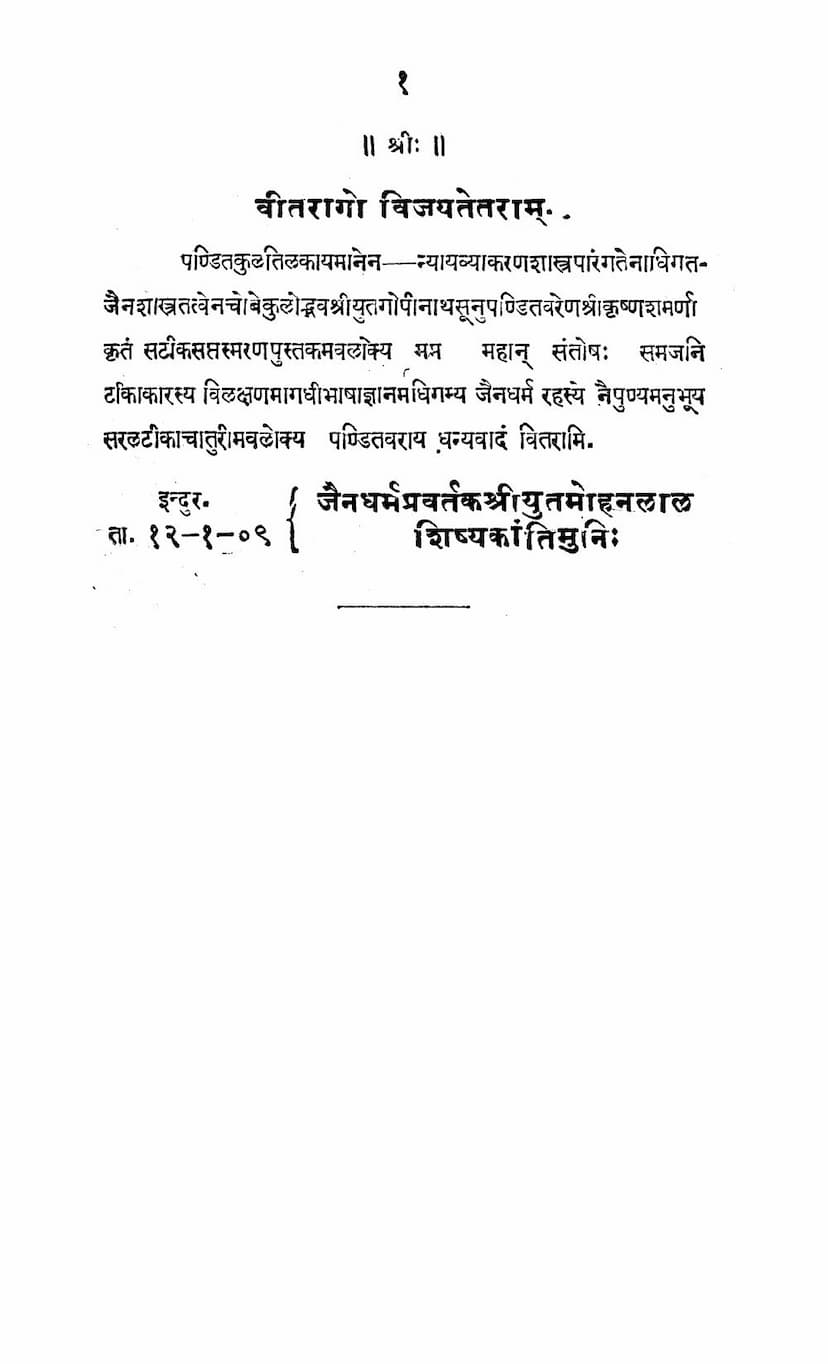Stotradi Sangraha
Added to library: September 2, 2025

Summary
Here's a comprehensive summary of the Jain text "Stotradi Sangraha," based on the provided pages:
Overall Context:
The document "Stotradi Sangraha" appears to be a collection of Jain devotional hymns (stotras) along with detailed commentaries in Hindi. The specific content provided focuses primarily on the "Ajitashanti Stavan" (Hymn to Ajit and Shanti) and includes introductory and concluding remarks, endorsements, and a separate hymn, "Ullasika Stotra" by Jinavallabh Suri, and "Namiyuna Stotra" by Manatunga Acharya, and "Uvasagharam Stotra" by Bhadrabahu. The primary aim of the work is to make these ancient Jain texts accessible to the general public, particularly Hindi-speaking Jains, by providing clear explanations and elaborations.
Key Figures and Their Contributions:
- Pandit Shrikrishna Sharma: The central figure and commentator. He is praised for his deep knowledge of Jain Shastras, Sanskrit, Magadhi, and Hindi languages. His commentary, described as "subodhini," is lauded for its clarity and accessibility. He is credited with making complex Jain texts understandable to the common person. The book is dedicated to his efforts.
- Kantimuni: Likely a disciple of Pandit Shrikrishna Sharma, as indicated by the inscription on Page 1.
- Pandit Shridhar Shastri: Endorses the work on Page 4, appreciating its value for Jain devotion and expressing gratitude to Pandit Shrikrishna Sharma.
- Siraymal Bapna (District and Session Judge, Mehidpur): Praises the originality of the work, noting that it makes the stotras accessible to all. He offers a constructive suggestion regarding the use of simpler words in the translation.
- Yeshvant Roe (Judge Nazim Diwani Adalat Court, Indore): Expresses great interest and acknowledges the work as a credit to Pandit Shrikrishna Sharma's erudition. He highlights the importance of making Magadhi texts understandable for those unfamiliar with the language.
- N. G. Modi (B.A., B.T., Magistrate, Indore): Knows Pandit Shrikrishna Sharma and commends his commentary on "Sapta Smarana" as useful for self-study. He encourages the Pandit to translate more Magadhi works into Hindi.
- Nathmal Bothra (Knasgee Khajanchi, Indore State): Expresses gratitude for the translation of difficult Magadhi prayers and prays for the long life of the Pandit, considering him a precious jewel for the Jain Swaitamber School of Indore.
Content of the "Ajitashanti Stavan":
The core of the provided text is the "Ajitashanti Stavan," which praises two Tirthankaras:
- Ajitnath (the 2nd Tirthankara): Known for conquering all fears. The text mentions the story of his conception, where his father, King Jitshatru, could not win games due to the influence of the powerful son in the womb, leading to his name "Ajit."
- Shantinath (the 16th Tirthankara): Known for bringing peace and tranquility. His conception marked auspicious times and the cessation of various disturbances, hence his name "Shanti."
The stavan describes the qualities of these Tirthankaras using various poetic meters (chhandas) such as Gatha, Shloka, Magadhika, Alingana, Sopana, Veshṭaka, Rasalubha, Chitra Lekha, Narachaka, Kusumalata, Bhujangaparirimgita, Khinjita, Lalita, and others. These descriptions highlight their divine attributes, their victory over passions and karmas, their renunciation, their spiritual prowess, and their role as guides to liberation.
Commentary ("Subodhini") by Pandit Shrikrishna Sharma:
For each verse or section of the "Ajitashanti Stavan," Pandit Shrikrishna Sharma provides:
- Chhaya (Shadow/Literal Translation): A Sanskritized translation of the original Magadhi verses.
- Padartha (Word Meaning): A word-by-word explanation of the Magadhi or Sanskrit terms.
- Bhavarth (Essence/Meaning): A clear and simple Hindi explanation of the overall meaning of the verse.
- Itihas (History/Narrative): Explanations of the historical or mythological context behind the verses, often relating to the lives of the Tirthankaras.
Other Hymns Mentioned:
- Ullasika Stotra by Jinavallabh Suri: This hymn also praises Ajitnath and Shantinath, using vivid imagery and emphasizing their power to bestow liberation and overcome obstacles.
- Namiyuna Stotra by Manatunga Acharya: This hymn praises Parshvanatha, the 23rd Tirthankara, highlighting his ability to overcome eight major fears: diseases, water, fire, poison, robbers, fierce animals, king's wrath, and demonic afflictions. The commentary explains how devotion to Parshvanatha removes these fears.
- Siddhavahara Stotra: This hymn focuses on removing obstacles and wishes for the well-being of the sangha and the followers. It invokes various deities and auspicious entities for protection and prosperity.
Themes and Significance:
- Accessibility of Jain Literature: A primary goal of this compilation and commentary is to make sacred Jain texts accessible to a wider audience.
- Devotion and Reverence: The text is filled with deep devotion and reverence for the Tirthankaras and Jain Acharyas.
- Spiritual Guidance: The hymns and commentaries offer spiritual guidance, emphasizing the path to liberation through virtuous conduct, knowledge, and devotion.
- Overcoming Obstacles: A recurring theme is the power of Jain stotras and devotion to overcome worldly obstacles, suffering, and negative karmas.
- The Role of Acharyas: The work highlights the crucial role of learned Acharyas in preserving, interpreting, and disseminating Jain teachings.
In essence, "Stotradi Sangraha," as represented by these pages, is a valuable resource for understanding and appreciating Jain devotional literature, made possible by the dedicated efforts of scholars like Pandit Shrikrishna Sharma.